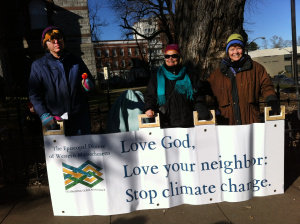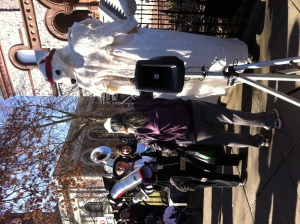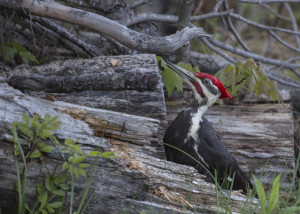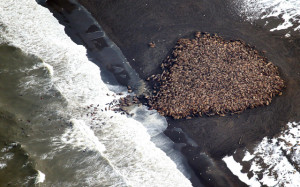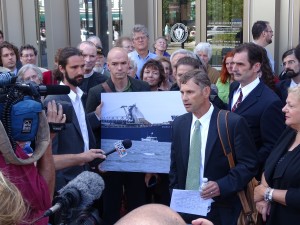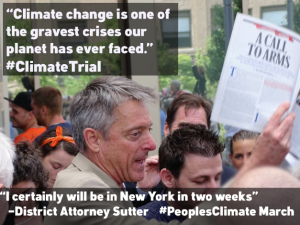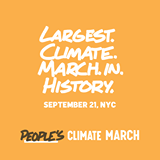Sermon for Trinity Sunday, June 15, 2014. Delivered by the Rev. Margaret Bullitt-Jonas, Grace-St. Paul’s Church, Tucson, AZ.
Genesis 1:1 – 2:4a
Canticle 13
2 Corinthians 13:11-13
Matthew 28:16-20
Holy Trinity: Joining the dance
It’s a pleasure to be with you this morning at Grace-St. Paul’s, and I want to thank your rector for welcoming me back. Some things have changed since the last time I was here. An array of solar panels has shown up on every roof! It’s fantastic! Some things in my own life have changed, too. Last fall I resigned from my job at Grace Church in Amherst, Massachusetts. I went to my bishop and told him that I didn’t want climate activism to be only a part of what I do – I told him that I felt called to focus all my energy on awakening people of faith to the urgency of tackling climate change, and that my dream is to help build a movement to protect life as it has evolved on this planet. Through the grace of God, funding was found, a position was created, and since January I’ve been serving the Diocese of Western Massachusetts as its first Missioner for Creation Care. Now I travel around the diocese like an itinerant 19th century Methodist minister on horseback, or maybe like Paul Revere, spreading the word from church to church that climate change is not only coming, it is upon us, it is here, and that as people blessed and sustained and empowered by God we have the great privilege and holy responsibility to rise up and to do something about it.
As I wrote today’s sermon, I had to do some wrestling.
How in the world does Trinity Sunday, which we celebrate today, connect with climate change? How does understanding God as Father, Son, and Holy Spirit help to inform and inspire our struggle to stabilize the climate and to pass on to our children and our children’s children a sustainable, just, and habitable world?
That is not an idle question, for the news from climate scientists in the last few months has been increasingly grim. Maybe you heard about the recent report from the Intergovernmental Panel on Climate Change, a United Nations group, which shows,
in the words of one reporter, that “climate change is already having sweeping effects on every continent and throughout the world’s oceans… and [that] the problem [is] likely to grow substantially worse unless greenhouse emissions are brought under control…[I]ce caps are melting, sea ice in the Arctic is collapsing, water supplies are coming under stress, heat waves and heavy rains are intensifying, coral reefs are dying, and fish and many other creatures are migrating toward the poles or in some cases going extinct. The oceans are rising at a pace that threatens coastal communities and are becoming more acidic as they absorb some of the carbon dioxide given off by cars and power plants…”
On top of this bleak news, last month
two landmark studies showed that the huge West Antarctic ice sheet is starting to collapse and slide into the sea in a way that scientists call “unstoppable.” Researchers had expected that, despite human-caused climate change, the ice sheet would last for thousands of years, but the new studies found that the loss is happening much more quickly than scientists expected. The slow-motion collapse will eventually lead to a rise in global sea levels of 12-15 feet, “overrunning many of the world’s islands, low-lying areas, and coastal cities.”
1
The environmentalist Bill McKibben has commented that it’s as if we were running Genesis backwards.
Given the perilous situation in which human beings and all other living creatures now find ourselves, what can we learn from the doctrine of the Trinity? What gift of hope can we receive as we consider the God we meet as Father, Son, and Holy Spirit?
A quick word about history: probably no doctrine of the Church developed with more contentiousness and controversy than the doctrine of the Trinity. After the life and death of Jesus Christ, generation by generation Christians searched the Scriptures and found hints and clues that suggested how to think about the nature of God. They pondered passages such as the ones we heard this morning. At the end of Second Corinthians, Paul blesses his community by invoking “the grace of the Lord Jesus Christ, the love of God, and the communion of the Holy Spirit” (
2 Cor. 13:13), and at the end of Matthew’s Gospel, Jesus commissions his disciples to baptize “in the name of the Father and of the Son and of the Holy Spirit” (
Matthew 28:18). From these biblical hints and clues, from their ongoing lives of prayer, and from their forays into Greek philosophy, in the 4
th century the teachers and scholars of the Church began to hammer out the doctrine of the Trinity. It took many acrimonious arguments to work out the phrasing of the Nicene Creed, and it took decades for that Creed to be accepted across the Church. In fact, one of the causes of the Great Schism between East and West was whether the Spirit proceeds from the Father or whether it proceeds from the Father
and the Son – the so-called “filioque” debate, to use the Latin word, as you’ll see in your service leaflet in the note at the end of the Nicene Creed. That is how much it mattered to the Church that we get it right when we think about the Trinity – a thousand-year-old Church split over who proceeds from whom!
I am grateful that our Christian forebears thought so rigorously about the nature of God, and that they gave us an intellectual framework for speaking about the divine. It matters how we think about God. But no matter how subtle, even brilliant, our analysis, there are limits to what the intellect can do. God is not an object – even a very big object – that we can separate from other objects and then analyze, dissect, and probe, as we might study a star in the sky or a specimen in a lab. God is not an object at all, but a mysterious Presence that abides within and beyond all things; not another being among many beings, but the very Ground of all being; not a monolithic, omnipotent Man in the Sky but a dynamic communion of self-giving love. We can’t know the Trinity from the outside, by thinking about it, but only from the inside, by experiencing it. As St. Augustine put it long ago, “We come to God by love, not by navigation.” And he describes the Trinity very simply as the Lover, the Beloved, and the love that flows between.
Step into that flow of love, and we are caught up in a love affair that has been going on since before time began. The divine Mystery that we call “God” is an ongoing exchange of love between God the Father – the Lover, the Creator – and God the Son, the Beloved. Flowing between them is the never-ending, tender love of the Holy Spirit. God is one, and yet God is also three, a dynamic relationship, a giving and receiving of love. When the early Councils of the Church debated the nature of God, they came up with a wonderful image of the Trinity as a dance. The word in Greek is
perichoresis and it means a “dance-around” of love. Imagine that! At the center of reality, a dance of love is in full swing!
Jesus came to invite us to join the dance. He was completely caught up in a love affair with God, his beloved
abba, which is the Aramaic word for Father, and through the Holy Spirit, our counselor and comforter and the guide who leads us into all truth, we, too, are drawn into the flow of love between God the Father/Mother and God the Son. Our baptism in the name of the Triune God signals the fact that God is not just “out there,” but also “in here,” and that from the very beginning, God has made a home in us.
At its most basic level, that’s what it means to be a Christian: someone who, through the power of the Spirit, connects with and trusts in the ever-flowing love of God that is circulating everywhere. Someone who bears witness in very tangible ways – even in the face of suffering and death – to the ongoing love, power and presence of God that fills the whole creation. Someone who knows, as we heard in the creation story from Genesis, that we are made in the image and likeness of God (
Genesis 1:26), who is a dance-around of love – which is why, when we give and receive love, we feel most joyful and alive, and most truly and fully ourselves. The so-called “dominion” that God gives to human beings in the Genesis story is permission not to dominate or exploit the other creatures of the earth, but rather to love as God loves, to exercise a dominion of love that protects the wellbeing and integrity of God’s creation.
So in the face of the climate crisis, we Christians have a chance to show who we really are: people whose very nature and truest identity is to love as God loves; people who are willing to face squarely the most challenging, even devastating facts; people who can reach into our reserves of courage, faith, and hope and can step out to bear witness to the God who entrusted the world to our care.
There is so much that we can do. We can recycle more, drive less, and be sparing in our use of water. Maybe we can eat local, organic foods and support our local farms and land trusts. We can install insulation and cut back on AC. As individuals we can and should do everything we can to reduce our use of fossil fuels, but the scope and speed of the climate crisis require action on a much broader scale, too. We need to join with other people and make it politically possible to do what is scientifically necessary. We need to push our political leaders to get this country and other countries on track to bring down the level of carbon dioxide in the atmosphere to 350 parts per million, the uppermost level that many scientists say is safe for life as we know it to continue on this planet. What is the level today? 400 parts per million, and climbing. So we have work to do. And the dance of love that is circulating within us will empower us to do this work.
The Diocese of Massachusetts recently decided to divest from fossil fuels, reasoning that if it’s unethical to ruin the world by burning fossil fuels, then it’s unethical to profit from that ruin. The Diocese of Western Massachusetts, where I serve, is in the midst of debating whether or not to divest its portfolio, and perhaps that it is a conversation that some of you can initiate or join here in the Diocese of Arizona. Divestment is one of the best strategies around for mobilizing a movement that will eventually accomplish what we really need: a stiff price on carbon and strong, binding international treaties.
Meanwhile
Bill McKibben has written an article calling for the largest rally in the history of the climate movement. It will be held in New York City on the weekend of September 20. As McKibben puts it, “If you’re wondering how to react to the devastating news that the Antarctic is melting out of control: New York. If you’re scared like I am by the pictures of the fire and drought across the West: New York. If you’re feeling like it’s time to change the trajectory of this planet: we’ll see you in New York.”
I’m not going to ask you to expand your carbon footprint by joining me in September at what’s being called the People’s Climate March, but maybe you can invite your New York friends to come, and your friends in New England, and anyone who lives, let’s say, a half-day’s train ride from Manhattan. The melting ice in West Antarctica may be unstoppable, but so is the love that made us and sustains us and calls us to stand up for life. There is so much left to save, so much good that we can do – if we act right now, so many ways to help build a better world.
On this Trinity Sunday we celebrate the living God who is beyond us, and among us, and within us, the God in whose image we are made, the God who meets us in every Eucharist and who sends us out to make love tangible and visible in the world. “Go,” the Risen Christ says to his disciples in today’s Gospel reading from Matthew. Don’t hang around and worship me. Go. Take part in my mission of mercy, justice, and compassion. Step into the dance and invite everyone else to join in, too. And, whatever comes, “remember, I am with you always, to the end of the age” (
Matthew 28:20).
c) 2014 Margaret Bullitt-Jonas
1. http://www.nasa.gov/press/2014/may/nasa-uci-study-indicates-loss-of-west-antarctic-glaciers-appears-unstoppable/#.U3FiNflLWRO
See also: http://www.nsf.gov/news/news_summ.jsp?cntn_id=131369&org=NSF&from=news;
http://www.biologicaldiversity.org/news/center/articles/2014/los-angeles-times-05-12-2014.html
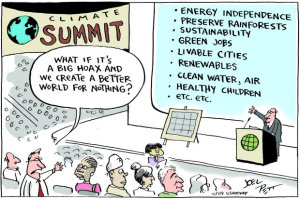
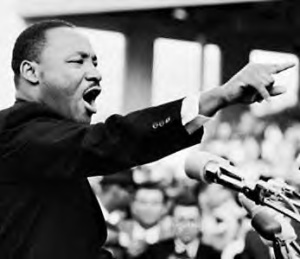 It is God who whispers that dream into our hearts, God who plants that longing in us like a seed that grows into a mighty oak, God who stirs us out of our complacency and sends us into action. It is God who gives us a heart to care, and strength to keep fighting the good fight. For it can be difficult to keep going, difficult to keep the faith in the face of sometimes brutal opposition and the sheer inertia of business as usual.
There is a wonderful scene in the movie
It is God who whispers that dream into our hearts, God who plants that longing in us like a seed that grows into a mighty oak, God who stirs us out of our complacency and sends us into action. It is God who gives us a heart to care, and strength to keep fighting the good fight. For it can be difficult to keep going, difficult to keep the faith in the face of sometimes brutal opposition and the sheer inertia of business as usual.
There is a wonderful scene in the movie 
